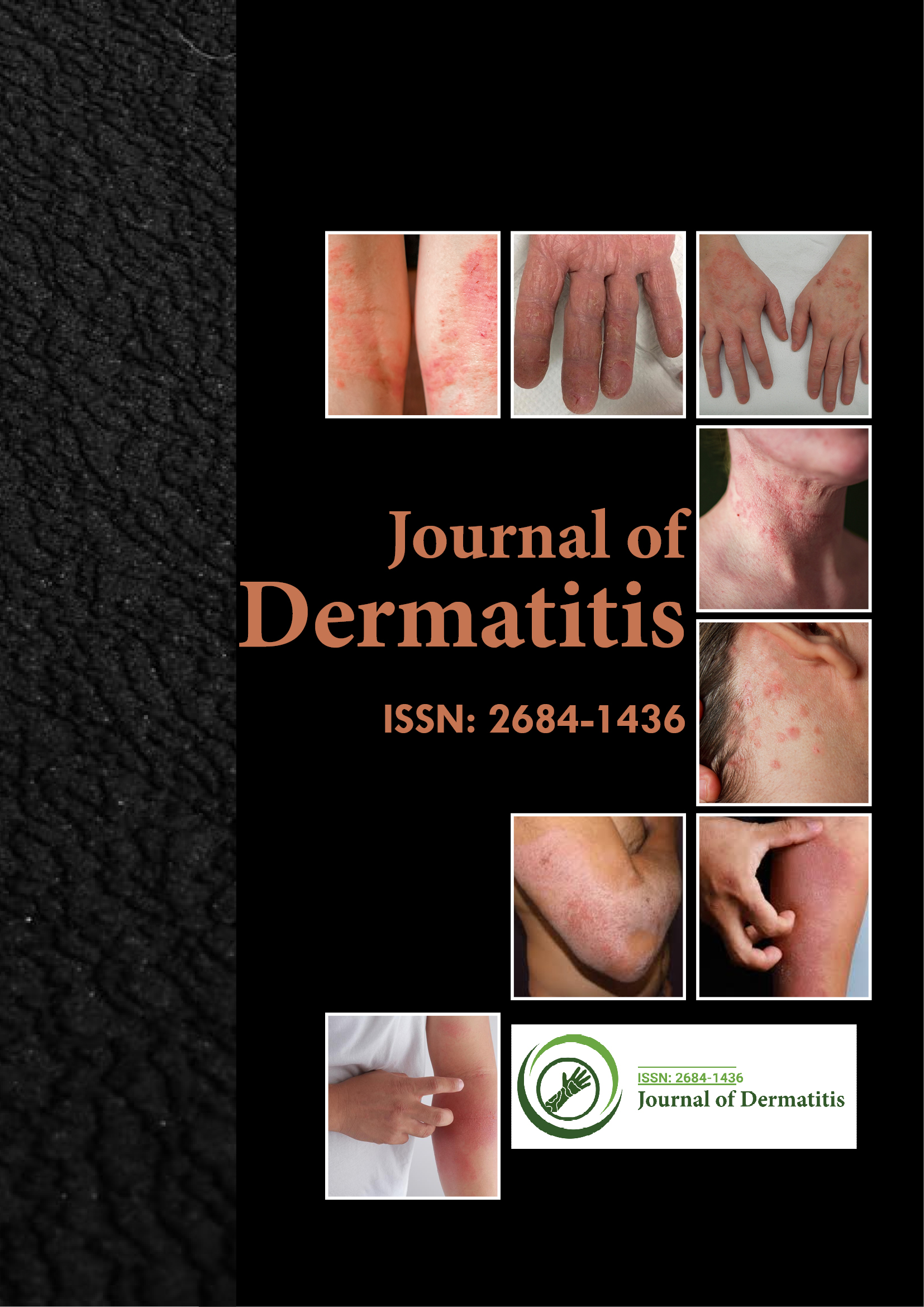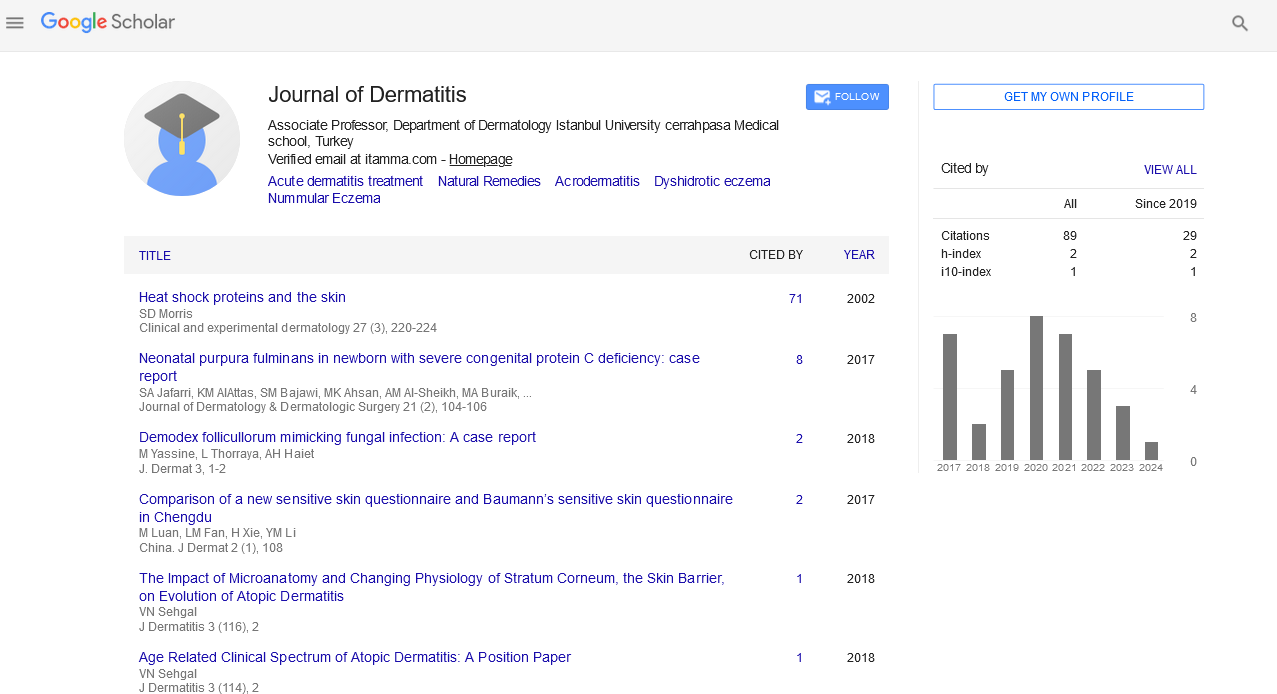Indexed In
- RefSeek
- Hamdard University
- EBSCO A-Z
- Euro Pub
- Google Scholar
Useful Links
Share This Page
Journal Flyer

Open Access Journals
- Agri and Aquaculture
- Biochemistry
- Bioinformatics & Systems Biology
- Business & Management
- Chemistry
- Clinical Sciences
- Engineering
- Food & Nutrition
- General Science
- Genetics & Molecular Biology
- Immunology & Microbiology
- Medical Sciences
- Neuroscience & Psychology
- Nursing & Health Care
- Pharmaceutical Sciences
Perspective - (2022) Volume 7, Issue 4
Treatment and Management of Acute Dermatitis
Simon Francis*Received: 01-Jul-2022, Manuscript No. JOD-22-17655; Editor assigned: 04-Jul-2022, Pre QC No. JOD-22-17655 (PQ); Reviewed: 18-Jul-2022, QC No. JOD-22-17655; Revised: 25-Jul-2022, Manuscript No. JOD-22-17655(R); Published: 01-Aug-2022, DOI: 10.35248/2684-1436.22.7.160
Description
Atopic Dermatitis (AD) patients typically do not need emergency care, but they may go there for treatment of acute flares brought on by bacterial infections and eczema herpeticum.
Moisturization in atopic dermatitis
Patients typically benefit from 5-minute, lukewarm baths followed by the application of a moisturiser like white petrolatum, depending on the climate. The skin can be moisturised with regular baths that include emulsifying oils (1 capful added to lukewarm bath water). The oil prevents evaporation to the environment outside and keeps the water on the skin. Three times per day is not too much of a burden for infants; once or twice per day is typically all that can be accomplished in adults. The body should remain wet after a bath.
In order to lock in moisture and enable water absorption through the stratum corneum, counsel patients to apply an emollient (moisturiser) such as petrolatum or aquaphor all over the body while wet. On moist skin, the ointment spreads easily. Prior to applying the emollient, use the active ingredient. It has been suggested that newer emollients like Atopiclair and Mimyx produce better results, but they are pricy and require more research.
Topical steroids in atopic dermatitis
Currently, the mainstay of treatment is topical steroids. Responses in relation to moisturization have been outstanding. In dry environments in particular, ointment bases are preferred.
For the first two days of treatment, lesions on the face and in the folds are treated with 1% hydrocortisone powder in an ointment base. The trunk lesions are treated with a mid-strength steroid ointment (triamcinolone or betamethasone valerate) twice daily until the eczematous lesions disappear. When lesions clear up, steroids are stopped, and they are started again when new patches appear. Seasonal changes, stress, physical activity, a staphylococcal infection, or a contact allergy can all cause flares. Although uncommon, contact allergy is the cause of an increasing number of flares. These are mainly seen when hydrocortisone is used.
According to the findings of a study from the Netherlands by Haeck et al. applying topical corticosteroids to the eyelids and periorbital area for AD poses no risk for the development of glaucoma or cataracts. A maintenance regimen using Acid Mantle's 1.25 percent hydrocortisone powder diffused as a steroid-based emollient is both effective and safe for longer periods of time, in addition to using higher-class steroids to treat acute flares quickly.
Immunomodulators in atopic dermatitis
A calcineurin inhibitor, tacrolimus (topical FK506) is an immunomodulator. Studies comparing hydrocortisone 1 percent and a placebo have shown excellent results. Little absorption takes place. Applying the medication only when the skin is dry will help to reduce any stinging that may happen after application. Usually, the burning goes away in 2 to 3 days. Tacrolimus comes in two strengths: 0.03 percent for children and 0.1 percent for adults, though some authorities frequently use the latter dose in young patients. The ointment tacrolimus is prescribed for moderate-to-severe AD. It is recommended for kids older than 2 years old.
Additionally a calcineurin inhibitor and immunomodulator, pimecrolimus 1 percent. It works better than a placebo. For use twice daily, pimecrolimus is produced as a cream. It is indicated for mild AD in patients older than 2 years of age and works particularly well on the face.
Based on studies showing a rise in malignancy in connection with calcineurin inhibitors, a black box warning was issued in the US in 2006. While these allegations are being looked into further, it is likely that the medication should only be used as directed (ie, for AD in persons older than 2 years and only when first-line therapy has failed).
These medications should only be used as secondary treatment because they are much more expensive than corticosteroids. Monoclonal antibody omalizumab inhibits IgE activity. Case studies indicate that it might be a useful treatment for AD, but a recent randomised, placebo-controlled trial found no change in the clinical course.
Citation: Francis S (2022) Treatment and Management of Acute Dermatitis. J Dermatitis. 7:160.
Copyright: © 2022 Francis S. This is an open-access article distributed under the terms of the creative commons attribution license which permits unrestricted use, distribution and reproduction in any medium, provided the original author and source are credited.

